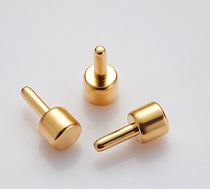Why is the surface of Pogo Pin corroded easily?

First, material characteristics
1. Metal activity Pogo Pin needles, needles and other components are usually made of metal materials, such as brass. These metals are more active in nature and easily react with oxygen and water in the air, resulting in surface oxidation or corrosion.
2. Electroplating quality In order to enhance the electrical conductivity, corrosion resistance and wear resistance of
Pogo Pin, a layer of metal, such as gold and nickel, is usually plated on its surface. However, if the quality of the coating is poor, such as insufficient coating thickness, uneven coating or defects, it will reduce its corrosion resistance and make the surface more prone to corrosion.
2. Manufacturing process factors
1. Electroplating process During electroplating, if the process parameters are not properly controlled, such as the composition of the plating solution, temperature, current density, etc. do not meet the requirements, it will affect the quality of the plating layer, and then reduce the corrosion resistance of the Pogo Pin.
2. Cleaning and drying After electroplating, if the Pogo Pin is not adequately cleaned and dried, the residual plating solution or water may corrode the metal surface, resulting in rust or oxidation on the surface.
Third, the use of environmental factors
1. Humidity and moisture In a humid environment, water is easy to invade the gaps and holes of Pogo Pin, and electrochemical reactions occur with the metal surface, leading to corrosion. Especially in coastal areas or saline-alkali areas, the corrosion rate may be faster due to the higher salt content in the air.
2. Temperature High temperature environments may accelerate the oxidation and corrosion process of metal surfaces. At the same time, the change of temperature may lead to the difference in the coefficient of thermal expansion between the coating and the base metal, resulting in stress, cracking or falling off the coating, and reducing the corrosion resistance.
3. Chemicals In some application environments, Pogo Pin may come into contact with acids, bases, salts and other chemicals. These chemicals may react with metal surfaces, causing corrosion.
4. Salt spray environment Salt spray environment is a common corrosive environment, mainly distributed in coastal areas and inland saline-alkali areas. The chloride ions in the salt spray can penetrate the oxide layer and the protective layer on the metal surface, and have an electrochemical reaction with the internal metal, resulting in corrosion.
Four, maintenance factors
1. Cleanliness If impurities such as dust and dirt accumulate on the Pogo Pin surface for a long time, the contact surface may be blocked, which affects the conduction of current and increases the risk of corrosion.
2. Frequent insertion or contact with the Pogo Pin may cause surface wear and scratches, reducing its corrosion resistance.
3. Storage conditions If the Pogo Pin is not taken appropriate protective measures during storage, such as being placed in a humid, high temperature or environment containing corrosive substances, it may also lead to surface corrosion.
5. Specific corrosion types and reasons
1. Oxidative corrosion When Pogo Pin is exposed to air, the metal surface is easy to react with oxygen to form an oxide layer. Although the oxide layer can protect the metal substrate to a certain extent, the oxide layer may become loose or fall off after long-term exposure to high humidity or high temperature, resulting in direct exposure of the metal substrate to a corrosive environment.
2. Galvanic corrosion If different parts of the Pogo Pin are made of different metals, or there is a potential difference between the plating and the base metal, galvanic corrosion may be formed. In a humid environment, the metal part with lower potential is easy to become an anode, accelerating corrosion.
3. Perforation corrosion When the plating of the Pogo Pin is too thin or defective, it may not be able to effectively protect the base metal. In the corrosive environment, the corrosive medium may penetrate the electroplating and directly corrode the base metal, forming perforation corrosion.
6. Preventive measures
To reduce the risk of Pogo Pin surface corrosion, the following precautions can be taken:
1. Select high-quality materials Select metal materials with good corrosion resistance and electroplating materials to improve the corrosion resistance of Pogo Pin.
2. Optimize the manufacturing process and strictly control the plating process parameters to ensure that the plating layer is uniform, without defects and the thickness is moderate. At the same time, strengthen cleaning and drying treatment to avoid the corrosion of residual plating solution or water on the metal surface.
3. Improve the use of the environment try to avoid Pogo Pin exposure to humidity, high temperature or containing corrosive substances in the environment. If it cannot be avoided, appropriate protective measures should be taken, such as the use of seals, coatings, etc.
4. Strengthen maintenance Regularly clean and check the Pogo Pin to ensure that its surface is clean and free of impurities. At the same time, avoid frequent insertion or contact resulting in surface wear and scratches.
In summary, the reasons why the surface of Pogo Pin is easy to be corroded involve many aspects. In order to improve its corrosion resistance, it is necessary to take comprehensive measures to prevent it from many aspects such as material selection, manufacturing process, use environment and maintenance.
